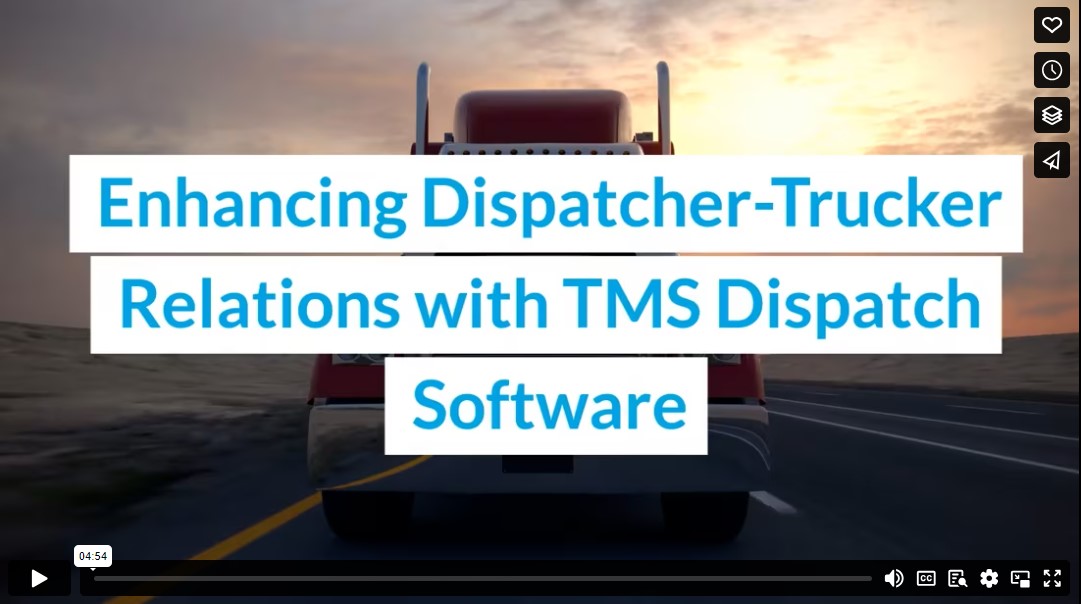Effective trucking relies on a strong dispatcher-trucker relationship.
Dispatchers count on truckers to execute delivery plans efficiently, provide on-the-ground feedback, and handle the physical aspect of transporting goods.
Truckers, meanwhile, rely on dispatchers for clear directions, timely information about traffic and weather conditions, and coordination with clients.
As a fleet manager, you can nurture this critical relationship by implementing TMS dispatch software.
Truths About Dispatching
Before exploring key TMS dispatch features, let’s review the challenges associated with dispatching.
-
- Multitasking and Pressure
Dispatchers manage a lot at once. They track trucker availability, handle shipment orders, and deal with unexpected delays. It’s a daily grind of coordinating 30 to 50 drivers, facing pressures from customers and unpredictable factors like weather and scheduling conflicts.
-
- Tight Delivery Timelines
Meeting short delivery windows is tough. The demand for faster online order deliveries strains dispatchers, especially when using manual dispatch methods.
-
- Limited Decision Authority
Dispatchers don’t have total freedom in assigning loads or granting privileges. Their choices are shaped by many elements, balancing company policies, trucker availability, and client needs.
-
- Routing Problems
Dispatchers face complex routing for multiple orders. Sudden roadblocks or weather issues can throw manual routing systems into chaos, leading to delivery delays.
-
- Customer Update Struggles
Keeping customers updated is challenging with manual systems. This can lead to customer dissatisfaction and an increase in queries.
Communication is key to streamlining dispatch operations
Truckers and dispatchers rely heavily on a clear, constant dialogue.
Most of the time, whatever truckers need to know or share with the company goes through dispatch. If this communication channel breaks, it’s trouble for everyone—the driver, the dispatcher, and the bosses.
There should be a clear understanding between truckers and dispatchers. Truckers must regularly update dispatch about their location, potential delays, or any road challenges they encounter. This information is vital for dispatchers to effectively manage schedules and expectations.
Dispatchers, in response, have to be proactive in relaying information about route changes, load details, and customer requirements. They are the bridge between the truckers and the rest of the operations. When dispatchers are well-informed and communicative, they can preemptively address issues before they escalate.
Boosting Dispatcher-Trucker Relations with TMS Dispatch Features
Trucking dispatch software plays a crucial role in improving the relationship between dispatchers and truckers. Here’s a look at some of its key features:
-
- Auto Dispatch for Busy Days
Imagine it’s a hectic Monday. The auto dispatch feature takes the load off dispatchers by lining up shipments and scheduling them to trucks on its own. Truckers don’t have to wait around for their next job—they get it automatically.
-
- Keeping Regular Routes in Check
Say you’ve got a truck that always runs the same route. The driver routing software component of the TMS can handle this like a pro, automatically creating orders for that route. This means dispatchers don’t have to manually set up each order, and truckers know exactly what to expect.
-
- Real-Time Tracking for On-the-Spot Decisions
Let’s say a trucker hits unexpected traffic. Real-time tracking lets dispatchers see this and reroute them in a snap. It keeps things flexible and responsive.
-
- Smart Routing Saves the Day
TMS looks at all the factors—traffic, roadwork, you name it—and finds the best route. Such insights save time and enhance delivery efficiency for truckers.
-
- Easy Document Access for Hassle-Free Trips
Gone are the days of lost papers and outdated instructions. Truckers can access delivery details, customer notes, and other documents right from the TMS. This makes each trip smoother and reduces the risk of errors.
-
- Feedback Loop for Continuous Improvement
After each trip, truckers can provide feedback directly through the TMS. This input is invaluable for dispatchers. It helps them understand what’s working, what isn’t, and how to make the truckers’ lives easier.
-
- Centralized Dashboard for Clear Communication
TMS offers a joint dashboard where both truckers and dispatchers can see the same info in real-time—things like where the load is, how the route is going, and when deliveries are due. This keeps everyone in the loop and builds trust, as both sides have a clear picture of what’s happening.
-
- Built-In Messaging System
In TMS, there’s a built-in messaging feature. Truckers and dispatchers can chat right in the app. It’s quicker and more straightforward than making calls or sending emails.
-
- Predictive Analytics to Stay Ahead
The system’s smart enough to predict problems before they happen. It might flag up a likely delay or a maintenance issue with a truck. This lets dispatchers give truckers a heads-up early, so they can plan around these issues.
Conclusion
These TMS dispatch features specifically target the improvement of trucker-dispatcher relationships. They create a more cohesive, understanding, and proactive working environment. You know just how crucial that is for your trucking company to operate smoothly.
Video




